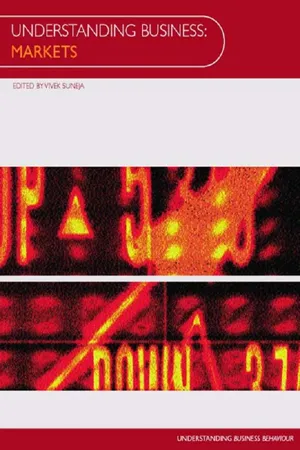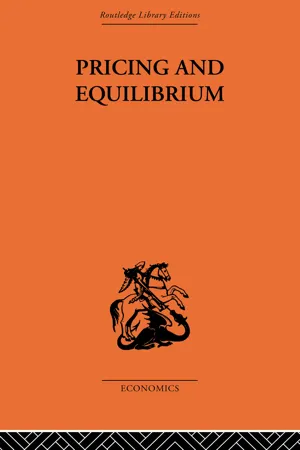Economics
Income Elasticity of Demand Formula
The income elasticity of demand formula measures the responsiveness of the quantity demanded for a good to a change in consumer income. It is calculated by dividing the percentage change in quantity demanded by the percentage change in income. A positive income elasticity indicates a normal good, while a negative elasticity indicates an inferior good.
Written by Perlego with AI-assistance
Related key terms
11 Key excerpts on "Income Elasticity of Demand Formula"
- eBook - ePub
Economics of Tourism and Hospitality
A Micro Approach
- Yong Chen(Author)
- 2021(Publication Date)
- Routledge(Publisher)
Y , for the good is given by the ratio of the percentage change in quantity demanded to the percentage change in consumer income:(5.11)η Y=(/)Q 2−Q 1Q 1(/)Y 2−Y 1Y 1.Similar to the other two ways of calculating the price elasticity above, we can calculate the midpoint income elasticity of demand using formula (5.8) and the point income elasticity of demand using formula (5.10) by simply replacing price P with income Y . Note that in the formulas for calculating the income elasticity we assume that the change in quantity demanded is due to the change in consumer income, other things being equal.The income elasticity of demand allows us to further classify goods beyond normal goods versus inferior goods, which we addressed in Chapter 4 . Obviously, the income elasticity of demand for normal goods is positive, denoted by curvesI 1,I 2, andI 3in Figure 5.4 . Very few goods are inferior goods with a negative income effect, and hence a negative income elasticity,I 4. Note that the distinction between normal goods and inferior goods is due to the nature of the relationship between demand and income with no regard to the magnitude of the income effect. Normal goods can be further classified as necessities and luxury goods based on the size of the income effect. The income elasticity of necessities is between 0 and 1, suggesting that a 1% increase (decrease) in income will lead to a less than 1% increase (decrease) in quantity demanded, denoted byI 2, other things being equal. The income elasticity of luxuries is greater than 1, suggesting that a 1% increase (decrease) in income will lead to a greater than 1% increase (decrease) in demand, denoted byI 3 - eBook - ePub
Understanding Business: Markets
A Multidimensional Approach to the Market Economy
- Vivek Suneja, Vivek Suneja(Authors)
- 2005(Publication Date)
- Routledge(Publisher)
extent to which demand changes as income changes. Income elasticity of demand measures the sensitivity of demand to changes in income. If consumers get an increase in income, their demand for some products may rise substantially, but their demand for other products may rise only very slightly, if at all.Income elasticity of demand can be measured by using the formula:If the value is more than one, demand is said to be income elastic, and if the answer is between zero and one, demand is said to be income inelastic. Most goods will fall into this range: that is, their income elasticity of demand will be positive, and the higher the value of the income elasticity of demand, the stronger the relationship is between changes in income and changes in demand. Luxury products tend to have a high income elasticity, while necessities have a low income elasticity. Thus the demand for foreign holidays or eating out is likely to be fairly responsive to changes in income, but the demand for bread is unlikely to change by much as income changes.For some products, however, the income elasticity of demand is negative, and these are referred to as inferior products. For these products there is an inverse relationship between income and demand, and an increase in income will lead to a fall in demand. The explanation for this is that as their income rises, consumers substitute better products in place of the ‘inferior’ products. Typical examples are public transport or cheap cuts of meat.Knowledge of the income elasticity of demand is important as it can help us to predict what will happen to demand as income levels change. Over time, living standards and the level of income have a tendency to rise. Using data on the income elasticity of demand for products, we can predict changes in spending patterns. We can expect to see a rise in spending on those products which have a high income elasticity of demand, such as eating out, electrical goods, foreign holidays and leisure activities, whereas for those products which have a low income elasticity of demand – for example, necessities such as bread, toothpaste, washing-up liquid – demand will rise only slightly. Expenditure on those products which have a negative income elasticity will fall. Thus the demand for public transport may fall as people switch to private cars. - eBook - ePub
Economics for Investment Decision Makers
Micro, Macro, and International Economics
- Christopher D. Piros, Jerald E. Pinto(Authors)
- 2013(Publication Date)
- Wiley(Publisher)
It should be noted that the relationships just described hold for any demand curve, so it does not matter whether we are dealing with the demand curve of an individual consumer, the demand curve of the market, or the demand curve facing any given seller. For a market, the total expenditure by buyers becomes the total revenue to sellers in that market. It follows, then, that if market demand is elastic, a fall in price will result in an increase in total revenue to sellers as a whole, and if demand is inelastic, a fall in price will result in a decrease in total revenue to sellers. Clearly, if the demand faced by any given seller were inelastic at the current price, that seller could increase revenue by increasing the price. Moreover, because demand is negatively sloped, the increase in price would decrease total units sold, which would almost certainly decrease total cost. So no one-product seller would ever knowingly choose to set price in the inelastic range of the demand.4.3. Income Elasticity of Demand: Normal and Inferior Goods
In general, elasticity is simply a measure of how sensitive one variable is to change in the value of another variable. Quantity demanded of a good is a function of not only its own price, but also consumer income. If income changes, the quantity demanded can respond, so the analyst needs to understand the income sensitivity as well as price sensitivity.Income elasticity of demand is defined as the percentage change in quantity demanded divided by the percentage change in income (I ), holding all other things constant, and can be represented as in Equation 1-25 .(1-25)Note that the structure of this expression is identical to the structure of own-price elasticity in Equation 1-24 . Indeed, all elasticity measures that we will examine will have the same general structure, so essentially if you’ve seen one, you’ve seen them all. The only thing that changes is the independent variable of interest. For example, if the income elasticity of demand for some good has a value of 0.8, we would interpret that to mean that whenever income rises by 1 percent, the quantity demanded at each price would rise by 0.8 percent.Although own-price elasticity of demand will almost always be negative because of the law of demand, income elasticity can be negative, positive, or zero. Positive income elasticity simply means that as income rises, quantity demanded also rises, as is characteristic of most consumption goods. We define a good with positive income elasticity as a normal good - eBook - ePub
A Primer on Microeconomics, Second Edition, Volume I
Fundamentals of Exchange
- Thomas M. Beveridge(Author)
- 2018(Publication Date)
- Business Expert Press(Publisher)
THINK IT THROUGH: Suppose that, tomorrow, the price of a gallon of gasoline doubled permanently. How effectively could you respond the next day or week? The next month? The next year? Most car owners would complain bitterly, but initially, would have to pay and suffer at the pump. We might trim back on some trips, but beyond that, it would be difficult to reduce fuel consumption. Carpooling, public transport, or biking might be feasible alternatives but many consumers are reluctant to change their preferred behaviors and traditions. With the passage of time, we might buy a new more fuel-efficient car, or move closer to work, or adjust our schedule to work at home one day, and so on, but all these responses take time to implement.Whether the User of the Good Is also the Buyer of the Good : Demand may be less price-sensitive if there is a disconnect between the person who uses a good and the person who pays for it.THINK IT THROUGH: If you have an expense account, or will be reimbursed for a purchase, are you really as discriminating about purchases as you would be if it were your “own” money?Income Elasticity of DemandIncome elasticity of demand (Yd ) looks at how much the demand (D) for a good changes as income level (Y) changes. From Chapter 2 , we know that there are normal goods and inferior goods. With a normal good , if income increases, then the demand for the good will increase—there is a positive relationship between “percentage change in income” and “percentage change in demand” when we have a normal good. However, the income elasticity of demand coefficient will be negative for an inferior good —as income level increases, the demand for an inferior good will decrease. Our intuitive formula would look like this:Yd = percentage change in demand/percentage change in income.More mathematically, this could be expressed the following way:Yd = %ΔD/%ΔYComment : - eBook - ePub
- Erich Schneider(Author)
- 2013(Publication Date)
- Routledge(Publisher)
Now an absolute change of dy in the income y results in a percentual change in the income y of the quantity. Corresponding to this we have a relative change in demand of the quantity. We define the elasticity of demand for the good No. i with respect to income, to be the relation between the relative change in the quantity demanded and the relative change in income. This income elasticity of demand (Y i) for the good No. i is, therefore, measured by the quotient: Though not quite exact for all purposes, it would usually be adequate to say that the income elasticity tells us by how much per cent the quantity demanded changes with an alteration (ceteris paribus) of 1 % in income. From the way the concept is formulated it is clear that the income elasticity is a pure number. Its magnitude also, as can be seen at once, is independent of the units of money and weight in which the income and the quantity demanded are measured. The reader should notice the assumptions on which the concept of income elasticity is based. All prices are treated as fixed. Only the income is changed by a small percentage. We then ask by how much per cent demand changes. It must also be noticed that an income elasticity of a particular amount is always related to a particular level of income, and generally varies with the level of income. If a household has an income of £500 per year, then the income elasticity for the good No. i will generally be different from what it would be if the same household, with prices unchanged, had an income of £1,000 per year. We have already shown that the quantity demanded usually increases (ceteris paribus) with an increase in income, and decreases only in the exceptional case of inferior goods. By using the concept of income elasticity we can now formulate this relation as being such that, in the regular case, income elasticity is positive, and in the exceptional case negative - eBook - ePub
Microeconomics
A Global Text
- Judy Whitehead(Author)
- 2014(Publication Date)
- Routledge(Publisher)
Countries aiming to benefit from a currency devaluation must pay special attention to price elasticities of demand for both their imports and for their exports. This is the foundation of the Marshall–Lerner condition, which states that in order for a fall in a country’s exchange rate (devaluation) to reduce the country’s Balance of Payments deficit (i.e. increase the country’s foreign reserves), the sum of the price elasticity of demand coefficients for exports and imports must be greater than one.3.3 The Income Elasticity of Demand
In addition to the price elasticity of demand, the income elasticity of demand provides a useful tool for the analysis of consumer behaviour and for planning by the firm or the state.3.3.1 Definition of income elasticity of demand
The income elasticity (This may be written as: or:ηY) for commodity x may be defined as:where the Y used for income in the above equations is really the Ȳ used to symbolize real (as opposed to nominal) income.As explained in Chapter 2 , the income-consumption curve (ICC ) is used to derive the Engel curve. The Engel curve is then used for illustration of the income elasticity of demand. The Engel curve shows the relationship between real income (Ȳ ) and the quantity of commodity x demanded (Qx).Using Figure 3.11 , the income elasticity of demand ηY for good x may be computed using the formula for income elasticity. The income elasticity at the point R (ηY (R )) on the Engel curve is found diagrammatically as follows:- Drop a perpendicular from the point R to the X -axis at S .
- Take a perpendicular from the point R across to the Y -axis at A .
- Identify from the diagram, the components of the income elasticity formula:
Figure 3.11 The Engel curve and income elasticity of demandIn the income elasticity formula given above, it is the inverse of the slope of the Engel curve that is represented by the expression:In Figure 3.11 , the slope of the Engel curve at the point R may be expressed as:- Hence, inverting the slope at the point R gives:
- Also from the elasticity formula, the following may be identified at the point R : Y = OA and Qx = OS . Hence:
- eBook - ePub
Microeconomic Principles and Problems
A Pluralist Introduction
- Geoffrey Schneider(Author)
- 2024(Publication Date)
- Routledge(Publisher)
Figure 10.17 include food, housing, gas, electricity, and tobacco.Examples of income elasticities.FIGURE 10.17Economists have also identified superior goods that are normal goods whose income elasticity is greater than 1: eGDP > 1. Examples of superior goods include automobiles, vacations, health care, books, restaurant meals, and meat. Superior goods tend to be luxuries or expensive items such as health care and housing that people are willing spend more on when their incomes increase. Notice, for example, that automobiles have an income elasticity of 3.0. Using the formula for the income elasticity of demand, this means that that a decrease in income of 10% would result in a decrease in the demand for automobiles of 30%! This is one of the main reasons why the car industry fares so poorly in recessions.On the opposite end are inferior goods that have an income elasticity of less than 0: eGDP < 0. People buy less of these goods when their incomes increase. Examples of inferior goods include margarine, rice, flour, and public transportation. Think about what goods you would stop buying if you had a lot more money than you do now. These are inferior goods to you.10.7.2 Cross-price elasticity of demand
Cross-price elasticity of demand measures the responsiveness of the quantity demanded of one good to the price of a different good. Specifically, the formula for cross-price elasticity, exy , is:e=x y=p e r c e n t a g e c h a n g e i n q u a n t i t y d e m a n d e d o f g o o d xp e r c e n t a g e c h a n g e i n t h e p r i c e o f g o o d y.% ▵QD x% ▵P yEconomists use cross-price elasticity of demand to measure the closeness of substitutes and complements. A substitute good has a cross-price elasticity that is greater than 0: exy - eBook - ePub
Microeconomic Theory second edition
Concepts and Connections
- Michael Wetzstein(Author)
- 2013(Publication Date)
- Routledge(Publisher)
∂Q/∂I)(I/Q ). Income elasticity of demand measures the percentage change in quantity to a percentage change in income, and is classified as follows:Table 5.3 lists the income elasticities for various foods, new automobiles, and gasoline. From this table, automobiles, fruits, and juices are luxury goods (η Q > 1), whereas bread, poultry, vegetables, and gasoline are necessary goods (η Q < 1). Considering the income elasticity of a new automobile ηQ = 1.70, a 1 percent increase in I results in a 1.7 percent increase in new automobile purchases.Income elasticity (η ) The percentage change in quantity given a percentage change in income. E.g., if the income elasticity of demand for DVD players is 3, a 1 percent increase in income would result in a 3 percent increase in demand for DVD players .Table 5.3 Estimated income elasticitiesCommodity Income elasticities Fooda Bread 0.578 Poultry 0.900 Vegetables 0.976 Fruit 1.160 Juice 1.042 Automobilesb 1.70 Gasolinec Short run 0.47 Long run 0.88 a K.S. Huang and B.-H. Lin, “Estimation of Food Demand and Nutrient Elasticities from Household Survey Data,” Economic Research Service, USDA, Technical Bulletin Number 1887, 2000.b P.S. McCarthy, “Market Price and Income Elasticities of New Vehicles Demand,” Review of Economics and Statistics 78 (1996): 543–547.c M. Espey, “Gasoline Demand Revisited: An International Meta-Analysis of Elasticities,” Energy Economics 20 (1998): 273–295.Table 5.4 Estimated cross-price elasticities of demand for selected food commoditiesSource - Available until 14 Jul |Learn more
Contemporary Economics
An Applications Approach
- Robert Carbaugh(Author)
- 2016(Publication Date)
- Routledge(Publisher)
price elasticity of demand measures how responsive, or sensitive, buyers are to a change in price. The price elasticity of demand looks at the percentage change in quantity demanded relative to the percentage change in price. The elasticity formula isE d=Percentage change in quantity demanded Percentage change in pricewhere Ed is the elasticity coefficient.11 The midpoint formula is used to calculate the elasticity between two points on a demand curve (or supply curve). This formula uses the averages of the two quantities and the two prices under consideration as reference points. According to the midpoint formula, the percentage change in quantity equals the change in the quantity divided by the average of the two quantities; the percentage change in price equals the change in price divided by the average of the two prices. Therefore, the price elasticity of demand equals:Suppose that attendance at the Lakers’ games decreases by 10 percent when the price of tickets increases by 5 percent. Thus, the price elasticity of demand is 2:E d=Change in quantity÷Sum of quantities / 2Change in priceSum of prices / 2The value of the elasticity coefficient, 2, suggests that game attendance changes 2 percent for each 1-percent change in the price of a ticket.E d=10 percent change in quantity demanded 5 percent change in price= 2You may have noticed that instead of 2, the value of Ed should actually be −2. This is because price and quantity demanded are inversely related according to the law of demand. In our example, the increase in ticket prices causes the numerator in the formula to be positive (+10 percent), while the decrease in game attendance causes the denominator to be negative (−5 percent). As a result, Ed - eBook - ePub
- John H Hoag(Author)
- 2012(Publication Date)
- WSPC(Publisher)
In this chapter, we have looked at topics related to the slope of demand. The important points you should take from this chapter are as follows: A. We isolated the income and substitution effects. B. The slope of demand is the substitution effect minus the income effect, which is Slutsky’s equation. C. Price elasticity of demand measures the responsiveness of the quantity demanded to changes in the price. D. Price elasticity is related to how expenditure on a good changes as we move along demand. In the next chapter, we turn to the firm and focus on the firm’s costs.Terms Defined: • Slope of demand • Same real income • Ratio of relative prices • Income effect • Substitution effect • Inferior good • Giffen good • Price elasticity of demand • Elastic, inelastic, unitary elasticity • Infinitely elastic • Infinitely inelastic1 - eBook - ePub
- Milton Friedman(Author)
- 2017(Publication Date)
- Routledge(Publisher)
5FIGURE 2.17FIGURE 2.18As we have noted, income elasticity is frequently used to define the terms necessities and luxuries. A good is termed a “necessity” if its income elasticity is less than unity, a “luxury” if its income elasticity is greater than unity.Unit income elasticity for all commodities would mean that the income-expenditure path on an indifference curve diagram would be a straight line through the origin. From the definition of income elasticity, it follows that kxηx1+ kyηyI+ . . . = 1, where kx is the fraction of income spent on X, ky on Y, etc.; andηxIis the income elasticity of X,ηyIof Y, etc.The Three-Fold Classification Implicit in Indifference Curve Analysis
The analysis of consumer behavior in terms of indifference curves implicitly classifies all factors affecting consumer behavior into three categories: (1) goods—these are the axes of the indifference curves, (2) factors determining opportunities—these are summarized in the budget line, and (3) factors determining tastes—these are summarized in the indifference curves.The important thing about this classification is that it is not given, once for all. It is a classification the contents of which are to be determined by the problem at hand, so that the same factor may for one purpose be treated as a good and measured along the axes, for another as an opportunity factor, for another as a taste factor.To illustrate, consider regional location. For a person considering where to settle, it is clearly a good, to be measured on one of the axes. Once he has settled, it is an opportunity factor, since it will affect the prices he will have to pay for various goods and services, and also, a taste factor, since it may affect the importance he attaches to winter coats versus bathing suits, or heating versus air-conditioning.
Learn about this page
Index pages curate the most relevant extracts from our library of academic textbooks. They’ve been created using an in-house natural language model (NLM), each adding context and meaning to key research topics.










